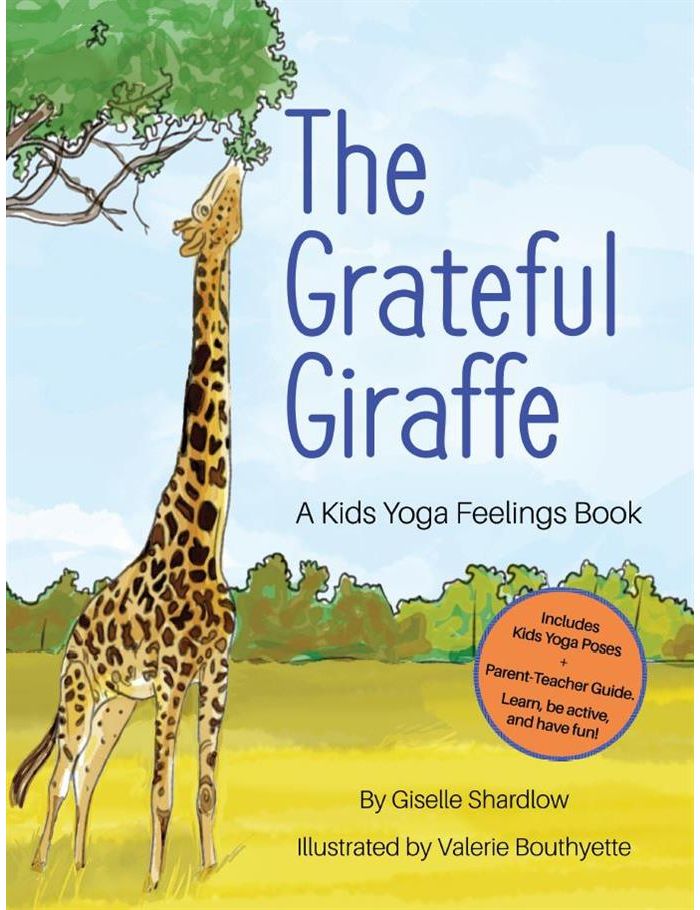I recently had the opportunity to review The Grateful Giraffe, by Giselle Shardlow. It is a sweet book featuring a variety of animals corresponding to yoga poses for children. I read the book and did the yoga flow with my kids one morning, and they really enjoyed it!
Giselle has included tips for how to use the book and how to use yoga in general with kids, and I loved that! There are illustrations of kids performing the poses on each spread, which is very helpful for young ones who need information in as concrete a manner as possible. I also really enjoyed the flow--it was one that I could probably teach to my kids to use without the book eventually. We added a simple mindfulness component to the rest pose at the end. As we lay in rest pose, we talked about five things we could see, five things we could touch or feel, and five things we could hear. It was a nice way to bring closure to the activity and add in mindfulness.
There is an extra layer to this book--it is not just animals and movement. Each animal is also connected to an emotion. This requires context, of course, which can be difficult to create with just two short lines of text and a picture. Occasionally, that context felt awkward or forced. I would probably start with reading the book and showing the pose, and focus just on the animal and action. With repeated readings, we could begin to explore the emotions piece of each context, with or without the yoga aspect. (What does it mean to be grateful? Why was the giraffe grateful?)

Animals are always fun and relatable, and since there is no clear theme to the types of animals--i.e., jungle, zoo, farm, etc.--it broadens the opportunities to use the book. To adapt for use in my classroom, I would use yoga chair poses, and if possible, display from my smart board so I would be hands free to demonstrate the full and adapted poses. I would also add some simple, calm music in the background.
I'm always about finding multiple ways to use a resource, and Giselle included extra resources at the end for just that sort of extension. Some other ways to use this book include the following:
1) Explore animals using active movement, not necessarily yoga poses.
2) Explore our bodies and how they can move from one yoga pose to the other.
3) Explore emotions using story context.
4) Relate animals to their home countries using the index in the back.
5) Discuss the animals' habitats using the illustrations.
6) Add in mindfulness components throughout, imagining what each animal can see, touch, hear, smell, and taste.
7) Add in a short 4 phrase song in between the animals and play musical instruments.
Here is a link to purchase the book (not an affiliate link as I'm not currently participating in that, yet!). Hope you enjoy! There are others in her shop you might want to check out as well.
Giselle has included tips for how to use the book and how to use yoga in general with kids, and I loved that! There are illustrations of kids performing the poses on each spread, which is very helpful for young ones who need information in as concrete a manner as possible. I also really enjoyed the flow--it was one that I could probably teach to my kids to use without the book eventually. We added a simple mindfulness component to the rest pose at the end. As we lay in rest pose, we talked about five things we could see, five things we could touch or feel, and five things we could hear. It was a nice way to bring closure to the activity and add in mindfulness.
There is an extra layer to this book--it is not just animals and movement. Each animal is also connected to an emotion. This requires context, of course, which can be difficult to create with just two short lines of text and a picture. Occasionally, that context felt awkward or forced. I would probably start with reading the book and showing the pose, and focus just on the animal and action. With repeated readings, we could begin to explore the emotions piece of each context, with or without the yoga aspect. (What does it mean to be grateful? Why was the giraffe grateful?)

Animals are always fun and relatable, and since there is no clear theme to the types of animals--i.e., jungle, zoo, farm, etc.--it broadens the opportunities to use the book. To adapt for use in my classroom, I would use yoga chair poses, and if possible, display from my smart board so I would be hands free to demonstrate the full and adapted poses. I would also add some simple, calm music in the background.
I'm always about finding multiple ways to use a resource, and Giselle included extra resources at the end for just that sort of extension. Some other ways to use this book include the following:
1) Explore animals using active movement, not necessarily yoga poses.
2) Explore our bodies and how they can move from one yoga pose to the other.
3) Explore emotions using story context.
4) Relate animals to their home countries using the index in the back.
5) Discuss the animals' habitats using the illustrations.
6) Add in mindfulness components throughout, imagining what each animal can see, touch, hear, smell, and taste.
7) Add in a short 4 phrase song in between the animals and play musical instruments.
Here is a link to purchase the book (not an affiliate link as I'm not currently participating in that, yet!). Hope you enjoy! There are others in her shop you might want to check out as well.

Comments
Post a Comment
Thanks so much for visiting and leaving a comment! I always check out content creators who leave links to their sites, so please share!